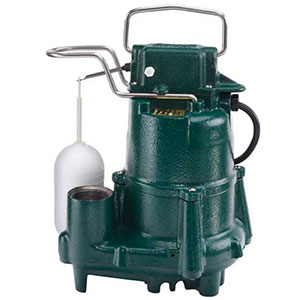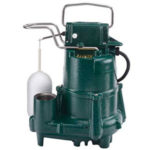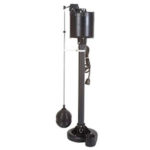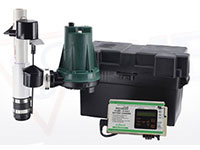Sump Pump Installation, Replacement, and Repair
24 Hour Emergency Service in the Louisville area!
 It’s a dark, stormy night. Rain is falling hard and there is no sign of it letting up. The rhythmic cycling of your sump pump turning off and on is a comforting sound. Your sump pump is the heart of your waterproofing system. A properly sized, installed and maintained sump pump is critical to keeping your basement dry. A sump pump failure during heavy rains could easily result in a flooded basement. Your B-Dry® Systems of Louisville consultant will offer expert advice when it comes to choosing the right sump pump type and configuration to help keep your basement dry.
It’s a dark, stormy night. Rain is falling hard and there is no sign of it letting up. The rhythmic cycling of your sump pump turning off and on is a comforting sound. Your sump pump is the heart of your waterproofing system. A properly sized, installed and maintained sump pump is critical to keeping your basement dry. A sump pump failure during heavy rains could easily result in a flooded basement. Your B-Dry® Systems of Louisville consultant will offer expert advice when it comes to choosing the right sump pump type and configuration to help keep your basement dry.
Need a sump pump installed or replaced?
We offer many configurations and emergency service.
Call us anytime (502) 968-4444
The manufacturers of sump pumps typically recommend that the pump be inspected at least once per year. If your pump runs frequently, it is a good idea to check it more frequently. A good sump pump inspection should verify pump operation; ensure nothing is hindering the movement of the float switch; confirm the check valve is functional; test and service battery back-up if equipped; replace high water alarm battery if equipped; and make certain the discharge line is unobstructed and pumping the water away from the home’s foundation. When inspecting the pump, the sump itself should also be cleaned removing all debris and any excessive dirt, gravel, or sand that has accumulated. Any obstructions in the sump could reduce the pump’s capability to pump water and possibly get into the pump impeller and stop the pump from running. If you would rather not trouble yourself with inspecting your pump and cleaning a dirty sump, your B-Dry® Systems of Louisville waterproofing expert will be pleased to do it for you. Just call us and schedule an inspection.
Sump Pump FAQs
A sump pump is a water removal pump that is typically installed in a sump basin below your basement floor or crawlspace. As water builds up underneath your foundation, it is moved to the sump basin by various means and the sump pump then pumps this water to an area outside the home to keep the basement from flooding.
There are many types and sizes of sump pumps available and each situation is unique. The amount of water the pump must move, the size of the sump in which the pump will be installed, the head (vertical distance the pump must raise the water), the size of the discharge line, and the turbidity of the water that must be pumped are all factors that should be considered. B-Dry® Systems of Louisville has more than 30 years experience in sump pump selection and installation and can provide expert advice if needed.
Types of pumps available include:
 Submersible Pumps
Submersible Pumps
Benefits – Most efficient, longer lasting, quieter, hidden in sump basin
Drawbacks – Require larger sump, more difficult to install

Pedestal Pumps
Benefits – Fits in small sumps, easy to install, lower cost
Drawbacks – Less efficient, shorter life, more noise, protrudes above top of sump

Battery Back-up Pump (DC Pump)
Benefits – Works during power outages, provides back up if main pump fails
Drawbacks – Requires periodic battery replacement, typically less efficient

Water-Powered Pump
Benefits – Works during power outages, does not require battery, provides back if main pump fails
Drawbacks – Low efficiency, difficult to install, uses tap water when operating, may require backflow prevention valve
This question is almost impossible to answer. Depending on the quality of your pump and the frequency that it runs, your pump may last 5 years or it may last 20 years. The challenge with knowing when to replace a sump pump is that they rarely show signs of wearing out. They simply stop working. Due to the serious consequences of a pump not working when it is needed, waiting for your pump to break before replacing is not the best strategy unless you have a robust back-up pump. If you only have a single pump, B-Dry® Systems of Louisville recommends you replace your pedestal pump every 5-6 years and your submersible pump every 8-10 years.
A check valve is a one-way valve that is installed in the pump discharge line. A check valve may not be a necessity, but is always a good idea. Since a sump pump is pumping water upwards in the discharge line, when the pump stops running any water remaining in the discharge line will drain back into the sump without a check valve. The pump will then have to pump this water out again thereby increasing the run time of the pump.
If you can’t afford to have water in your basement, a back-up or secondary pump is highly recommended. During a power outage, which often happens during heavy thunderstorms, your primary AC sump pump will no longer run until power is restored. Further, there is no guarantee that your primary AC sump pump won’t fail. Even new pumps sometimes fail prematurely. A back-up or secondary pump can also provide additional capacity should the amount of water entering your sump exceed the capacity of your primary pump. To prevent water in your basement in any of these situations, it is a good idea to have either a back-up pump or a secondary pump, preferably one that can be powered by a battery during a power outage.
It is also a good idea to install a high water alarm in your sump so you will know if water is rising in your sump before it overflows into your basement. Your B-Dry® Systems of Louisville consultant can help you design an effective sump pump system to greatly reduce the chance of water overflowing onto your basement floor.
We often receive calls from customers who are concerned because they have not heard their sump pump run in a while. In most instances, there is no problem with the pump. There is just not sufficient water in the sump to activate the pump switch. If you want to verify your pump is functioning, the very best method is to slowly pour water into the sump. Depending on the set point of the pump switch, the pump should turn on and pump the water out of the sump when the sump is less than 2/3’s full.
Warning! A sump pump with an electrical short can be deadly. Never contact a defective sump pump or the water in which it sits while the pump is plugged into a working electrical outlet. Always thoroughly read the manufacturer’s instructions before attempting to test a sump pump.
If you cannot easily put water into the sump, you can also check to see if your pump will run when energized. This method will tell you if your pump runs but will not necessarily tell you it will pump water. To check a pump equipped with a piggyback-style plug (where the pump plugs into the back or side of the switch plug) you can unplug the pump’s plug and put it directly into the power outlet. The pump should immediately run. Do not leave the pump running like this however, or the pump may overheat. If you can access the float switch on your pump, raising it up with a pencil or other small object to the on position should also cause the pump to run. If the pump does not run or makes abnormal noises during these tests, B-Dry® Systems of Louisville recommends that you have the pump tested by an experienced waterproofing specialist.
